The Lord of the Rings: Gollum is a travesty of a videogame that disappoints on almost every single level. It’s a shame because on paper I actually think the concept is quite strong. Gollum is a conflicted character constantly at war with himself, the two sides of his personality attempting to exist in one body. The more innocent Smeagol is the remnant of what he once was before being corrupted by Sauron’s ring, and then there’s Gollum, the wretched monster created by the influence of such a dark and terrible object. There’s a lot of story potential there and Daedelic tries to bring it into the actual gameplay during brief sections where you have to make a choice and then persuade either Gollum or Smeagol to go along with it. And choosing to focus on platforming and stealth makes total sense for the character because while his wiry frame is deceptively strong he’s not a warrior and is too cowardly to get into fights. But man, it does not come together.
Daedalic has a strong pedigree, just not in this kind of game. They’ve built themselves a reputation for excellent point-and-click titles, from the brilliantly bonkers Deponia series to the charming Night of the Rabbit. Each one featured beautiful graphics, and memorable characters and was polished to a shine. So when Daedalic announced The Lord of the Rings: Gollum my eyebrows shot up like two horny caterpillars – a fully 3D stealth game with platforming elements? And based on arguably the most known fantasy books of all time? Surely this small developer was diving into Mount Doom thinking it was just a paddling pool. After playing through the whole 8-10 hour campaign, I think my initial thoughts were right: every inch of this game felt like a developer entirely out of their depth was at the helm, desperately trying to stitch something shippable together. No wonder it quickly became the worst-reviewed game of the year.
Available On: Xbox Series S/X, PS5, PC
Reviewed On: PC
Developed By: Daedalic
Published by: Daedalic
Time Played: 10-hours
Gollum is also a tricky character to work with. He’s one of Tolkien’s most complex creations, a broken creature living a life of misery simply because he came in contact with something evil. And what could Daedalic do with him, really? Gollum has to be in place for The Fellowship of the Ring and can’t have his personality changed in any substantial way. The only thing they could do is try to flesh Gollum out and make him more sympathetic, which could impact the movies and the books by making you feel something deeper for the character when you experience them. And at first, it seems like that might be the plan. Daedalic gives Gollum a few chances to be somewhat nice compared to his usual self-servicing methods, to convey himself as more than just a slimy little bastard who tries to frame Samwise Gamgee for eating all the food. Hell, they even have Gollum make a few friends and hatch a tiny bird that views him as its dad. But then during one section in particular, Daedalic shoots themselves in the foot by having Gollum do something horrible, and the worse thing is that they give you a “choice” about what to do and they do it anyway. And so by the end of the game, Gollum is exactly what he always was: an opportunistic, slimy little hobgoblin that’s obsessed with his ring and the Hobbit that stole it.
Story-wise, the game tracks Gollum’s time between the theft of his ring by that nasty Bagginseses and his appearance in The Fellowship of the Ring. There’s a gap of around 6 years there, and Daedalic says they brought in experts on Tolkien’s deep lore to help craft a story that would fit in properly in terms of canon. In this regard, I think they succeeded: the game does a pretty good job of fitting into the canon, by which I mostly mean it doesn’t ruin anything or leave behind a bunch of weird plot holes, provided you’re willing to accept Gollum having a pet bird that doesn’t immediately eat.
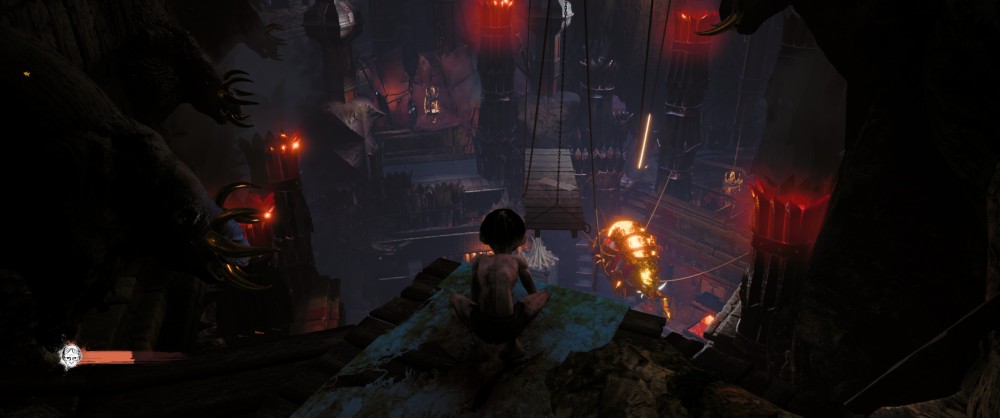
But the actual story is pretty dull. The vast majority of it takes place in Barad-dûr, an underground prison that Gollum is tossed into after stupidly trying to chase a bug and falling down a hill. No, I’m not just making that up. Much of the early hours are spent doing utterly menial chores like collecting the tags of some dead orcs, with only a couple of poorly written storylines to justify any of it. There’s some nonsense with your frail old cellmate that goes nowhere, and some mild Mordor politics with the Candle Man, a sorcerer that seems to find Gollum useful as a spy in the prison, even though Gollum does nothing. Again, the story of the Candle Man goes nowhere.
Gollum’s a surprisingly spritely little bastard when it comes to getting around. Not only does he move quickly, he can also jump quite high, swing on bars and, clamber up clearly marked walls. Platforming hits all the notes you’d expect of it really, requiring very little in the way of thought or skill to traverse the environments. The most creative it gets is jumping backwards off a wall, a tricky thing to do because the tight areas and the camera often mean you can’t see, so you have to rely on the button prompt appearing to let you when to take the leap. Nor does Daedalic attempt to blend the platforming elements into the rest of the environment, so a cliff face will just have random yellow, straight lines sunk into it so Gollum knows exactly where to go. Other games at least attempt to hide this stuff and make it look like part of the world, but I guess in The Lord of the Rings: Gollum, Sauron really works hard to keep health and safety standards high.
It’s basically the Uncharted or Tomb Raider style of platforming, except it lacks the cinematic flair and smoothness that makes those games enjoyable. Gollum will sometimes fail to do what’s asked of him, or somehow miss a jump completely because, unlike the games I mentioned, his animations aren’t canned and thus a sideways leap from handhold to handhold is not guaranteed to actually work. Except when it is canned and he is pulled to a handhold mid-jump like a magnet has just been activated. It’s bloody frustrating, especially because the game’s communication skills about where to go and what can or can not be reached are incredibly vague. It resulted in dozens of annoying deaths where Gollum didn’t grab the pole or where a platforming sequence didn’t work as intended because the developers mashed it together and just assumed it would be fine. But even when the long platforming sections do work they are boring because you’ve done all of it in dozens and dozens of other games, and those games were quicker or smoother or required more skill or just had nice scenery to clamber around.
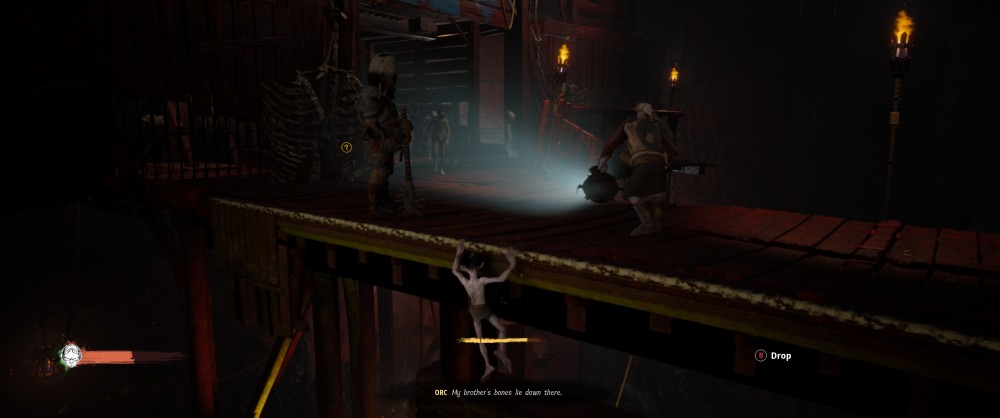
You’ll put these platforming mechanics to the test in the first few hours which are by far the most dull. Stuck in prison, Gollum’s first tasks are to herd some beasts into a cage, then collect some tags from dead Orcs, and then pour some slop into the breeding pits where the Uruk Hai are being grown. Each of these jobs is broken up by returning to your cell and hitting a key to go to sleep, a completely pointless design element because there’s literally nothing else you can do anyway, so why make the player trudge back to the cell and hit a button? This is the kind of weak mission designs you can expect from The Lord of the Rings: Gollum, and it only gets a little better as the game goes on.
The other big focus aside from platforming is sneaking around, something which Gollum is incredibly good at in the source material. All of his abilities at staying hidden mean little, though, when the stealth segments are so poorly designed. It’s as basic as stealth can be: hide behind stuff, crawl through shadows or flowerbeds to become completely invisible and throw some rocks to distract the idiotic AI. Gollum has a special intuition view that lets him track enemies through walls, so you just wait for a gap, amble over to the next obvious shadow or object and repeat until bored. At least it’s better than the climbing, I guess.
Gollum even occasionally gets to murder an orc. I like that Daedalic kept this rare, and when you do strangle an orc it takes ages because poor little Gollum has to put all of his weight and effort into choking the much larger beast. It helps keep killing a tense experience, rather than a commonplace act. It’s kind of confusing, however, that Gollum can’t strangle an Orc if it’s wearing a helmet.
Occasionally, The Lord of the Rings: Gollum tries to get a little adventurous by throwing in random stuff, some of which doesn’t make sense and most of which is poorly executed. Ordering companions around, for example, is a tedious and mind-numbing process because of how slowly they move and because of how simplistic the puzzles are. But there’s a specific example I want to use because it’s so weird and a perfect method of describing how clumsily the whole game has been put together. I was stuck for a few minutes during a platforming section trying to figure out where I was meant to be going. I tried a few experimental leaps to other platforms and fell to my death. On the third attempt, I accidentally brushed a beam and it fell over, forming a bridge. The reason this stands out as odd is because the game hadn’t used a mechanic like this in the previous 4 hours, and it never used it again, nor did it provide any sort of indication that knocking over the beam was a possibility. It’s just this strange, singular use of an idea like someone put it in and then forgot about it.
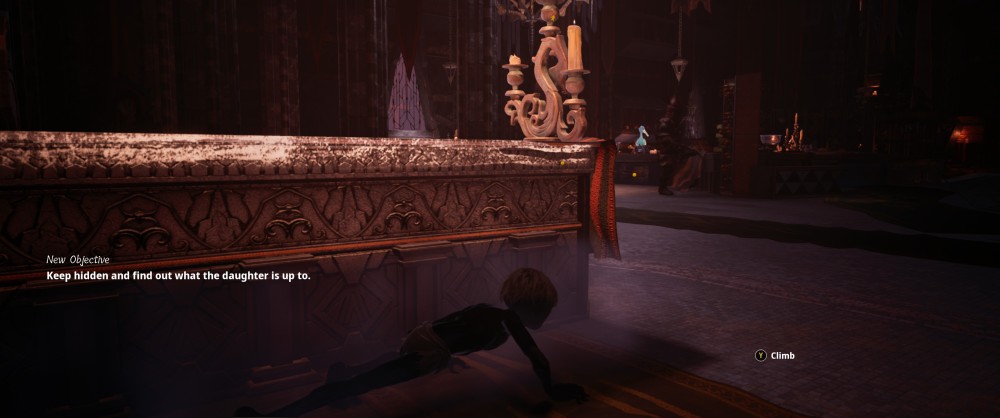
There’s even one of those God-forsaken chase sequences from the early 2000s. You know the one, where you have to outrun a pursuer by charging directly at the camera and jumping/dodging obstacles that come up the screen towards you? Yes, I kid you not, in the year 2023 Daedalic thought this was a good idea. It wasn’t. It’s terrible. Daedalic vaguely attempts to combat the inherently shitty design of this by having a weird green path that tells you where to move and when to jump, but all that did was make me question what it was and why it was there? Did some helpful Orc come along and drop green dots in case some crack-head creep came scuttling along?
There are literally dozens of other oddities like this that I could list, all of which point to a game that feels like it was taken apart and rebuilt again and again and again. There are strange scene transitions, baffling environments that don’t make any sense and heaps of details missing, the kind that you don’t even think about until they aren’t there. Like, why isn’t there a sound for when an Orc smacks you in the head when it catches you?
I actually think that using Gollum’s split personality as a mechanic is a cool idea. But these moments are nothing but an illusion of choice, designed in such a way as to make you feel like you have influence over the story when you actually don’t. Gollum and Smeagol’s arguments do nothing, and the best example of this comes later in the game. I won’t spoil anything so suffice to say that you’re given a choice: wake up an evil creature and let it do something horrible so that you can sneak through, or leave it sleeping. I sided with Smeagol and easily convinced Gollum to go along with it. So what did the game do? Well, it ignored my input, and instead the scene instantly cut to Gollum saying “Over there! Run!” and the giant monster waking anyway. Not only was there never any choice, then, but the developers didn’t even include a proper explanation or transition if you sided with Smeagol. What was the point? Why did it wake up anyway?
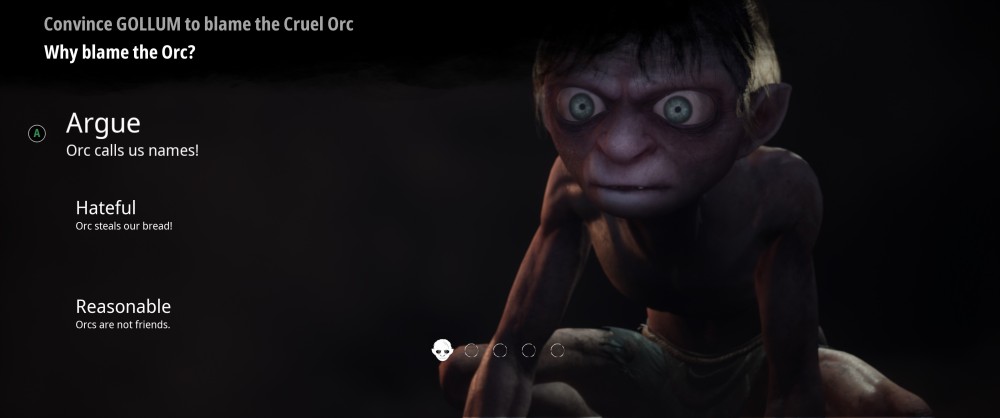
No amount of tweaking and twiddling with the limited settings could get Gollum to run smoothly. I kept running into frame drops, sometimes at inconvenient times like a chase sequence. It’s not like it’s a demanding game, either: the various map sections are all quite small, there’s minimal AI and the graphics are low quality across the board. Even people with top-of-the-line machines are struggling to get it running well, and Daedalic themselves have acknowledged the performance woes.
Going back to the graphics, this is an ugly game, and not in the way that Gollum is supposed to be ugly. The facial animations are the worst offenders, easily ranking amongst some of the worst I’ve seen in the past few years. They are stiff in movement and often cut back to a character’s default look without any sort of transition, something that was most noticeable when the Candle Man was talking, although Gollum does it too. Character models look horrible, with Gollum himself looking far worse than his own counterparts in the movies or something like Middle-Earth: Shadow of War. Yes, he’s supposed to be gaunt and ugly, but this version of Gollum looks like someone hit a crack addict in the face with a shovel and then called it a day. The environments are drab and lacking in detail, too, and some of the heavily armoured Orcs look like Shrek when was wearing the knight’s armour in the first movie.
To put it simply, The Lord of the Rings: Gollum looks like something out of the late PS3 and Xbox 360 era. You might accuse me of being hyperbolic, but I think you could easily name dozens of games from that era that look artistically and technically better than Gollum, and that don’t use as many freaking loading screens despite having small environments. In fact, the original Middle-Earth: Shadow of Mordor launched 8 years ago on PS3 and Xbox 360 and looks considerably better. Let’s not forget that the recommended specs for Gollum call for an RTX 4090. What kind of fucking Pipe Weed was Daedalic smoking?
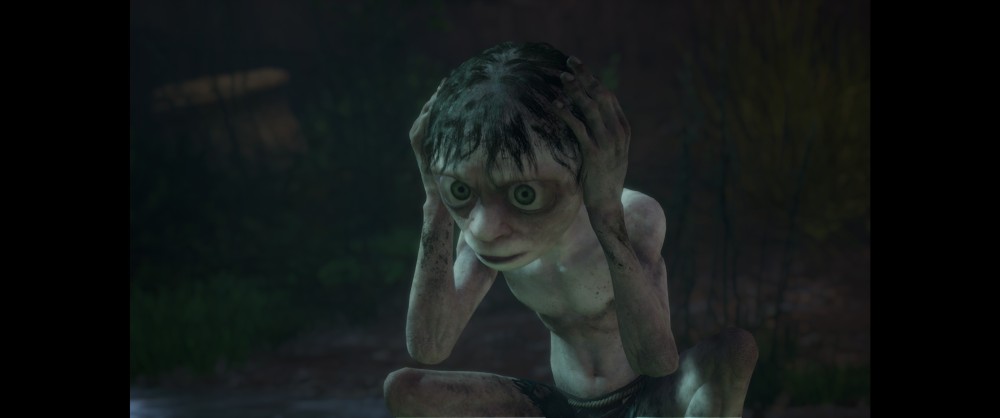
I can’t finish this review until I mention Daedalic’s abysmal use of DLC, either. As part of the special Precious Edition or as separate purchases you can get an in-game lore compendium and concept art. Both of these are things most triple-A titles include for free, yet Daedalic sought to charge for them, an especially egregious error considering how poorly the compendium is written. Or you can choose to buy “iconic” emotes for Gollum for £1.99, adding nothing to the game except a few crappy animations. But the worst thing is a piece of £1.99 DLC which adds more “authenticity” to the game by providing a Sindarin voiceover for the Elven characters. I shit you not.
This was not a good way for Daedalic to kick off its use of the Lord of the Rings license and certainly doesn’t inspire confidence in their next Lord of the Rings project. Although I do think the premise for the game was good, The Lord of the Rings: Gollum is a slog to get through. The boring missions, bland environments, flat gameplay, poor graphics and average story combine to make this, at best, a completely mediocre experience. But once you take the multiple issues into consideration and the fact that Daedalic wanted £60 for it, The Lord of the Rings: Gollum becomes like its namesake: a pitiful wretch corrupted by the allure of the One Ring.
